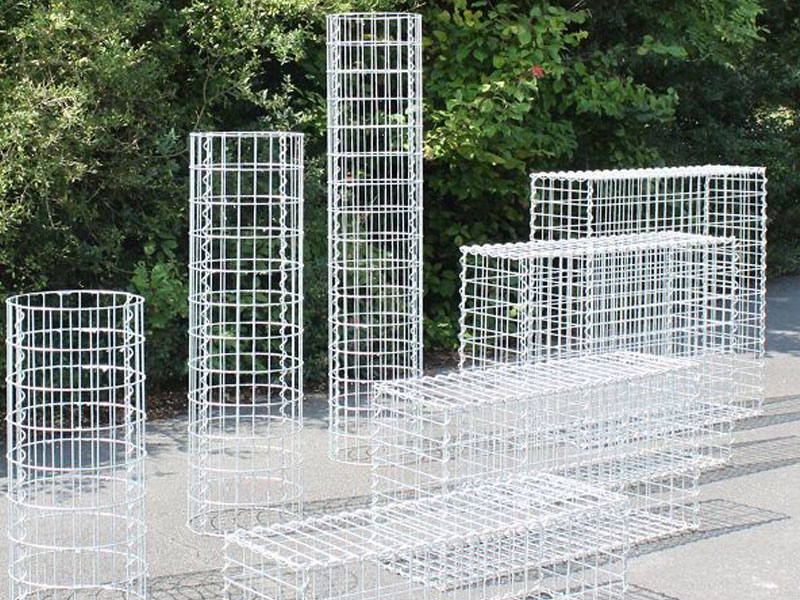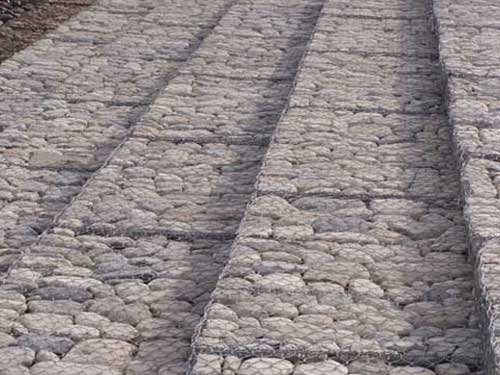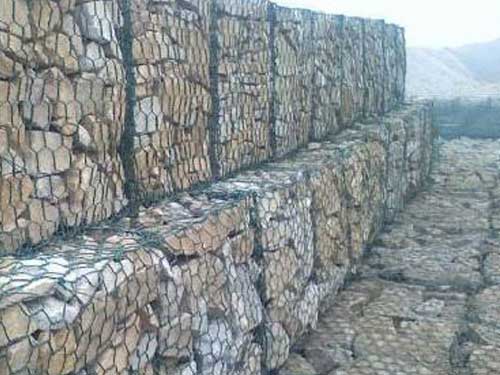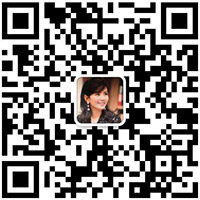1.What is a gabion?
In actual construction, the gabion is somewhat like a cage. The cage may be cylindrical or in the shape of a square or rectangular box. The cage may be constructed with a number of different materials, depending on the application. In some cases, the gabion is made with the use of metals, while gabion that are intended for temporary use may be composed of an outer shell of canvas or a similar material. Even wick has been used as the material of choice for a gabion.
2.What are the characteristics of the wire used to make the gabion mesh?
Gabion mesh is made from soft annealed steel wire which is additionally coated to increase its durability and design life. The coatings include: zinc galvanized, Galfan (a eutectic Zn-Aluminum (5%) MM alloy); zinc galvanized with PVC coating.
3.Where gabions and gabion walls are used?
Gabions can be used in many ways, including: retain unstable slopes; provide erosion control to rivers, channels and shorelines; create acoustic barriers; dressed architectural buildings and many other applications that require a permeable, flexible, durable and very cost effective structure.
4.How are gabion walls designed?
When used as a mass gravity retaining structure, gabion walls are designed in accordance with standard engineering practice; stability must be checked against sliding, overturning, bearing capacity and overall stability. The GawacWin software, downloadable from our website, makes the design process very rapid. When used in erosion control applications, gabions protect the erosive surface by providing resistance to the tractive forces applied by the fluid flow. The thicker the gabion and larger the average size of stone fill, the greater the shear resistance it offers. The Macra 1: 2002 software, downloadable from our website makes the design of channel and stream bank erosion control solutions very rapid. Weirs are designed using Macra 2:2002 software.
5.How long does a gabion wall last?
The gabion mesh is available with different coatings. The coating selection is made depending upon the environmental conditions (physical and chemical) the gabion is expected to encounter more severe environment. For example, a dry wall situation is likely to require a galvanized only coating, whereas a maritime environment or a structure requiring a longer design life would use a PVC coated galvanized wire unit. It is recommended that any structure in permanent contact with water (through immersion, proximity or spray) use PVC coated gabions. Channels often transport a bed-load of debris which will impact the gabion units and a PVC coated product is therefore appropriate. We have exhumed a number of old structures and tested the residual performance of the mesh. The results of these tests indicate a design life of the PVC coating can achieve 70 years when not exposed to severe environment.
6.What type of rock fill is recommended for gabions?
Gabion rock fill should be hard, durable, dense and non-frost susceptible, with a dimension of 4-8 diameter. A block shaped rock will be easier to install, and produce a better finish than a rounded cobble shaped rock. To maximize the mass of the structure, it is necessary to minimize the void volume of the fill within the gabion unit. i.e. more rock, less air. We do not recommend that smaller rocks be used as they will fall through the apertures in the mesh. However, there are certain specific circumstances when smaller rock can be used. The range in sizes may allow for a variation of 5% oversize and/or 5% undersize rock, provided it is not placed on the gabion exposed surface. Our Product Installation Guide for gabions provides further detail.
7.How can I calculate the amount of rock needed for my project?
Gabion rock fill is generally supplied by the ton. Depending upon the density of the rock fill at your local quarry, the final tonnage you order will vary. As a rule of thumb, gabion rock fill is going to be around 1.4 -1.5 tons per cubic yard. This would allow for overfilling of units and some wastage. It assumes that the gabion is 25-35% voids, and that the density of good rock fill is 155lb/CUft.
8.Is it possible to add vegetation to a gabion wall?
Vegetation or green engineering solution can be incorporated in many ways using live plants and cuttings, good quality topsoil, and erosion control mats. Our Soil Bioengineering Manual and CD Rom, available from our website, are packed with information.
9.How are gabions delivered to the project site?
The gabions are delivered folded up and closed in bundles of about 1200-2000lbs, each bundle containing a certain number of units.
10.Can gabions be pre-filled and then lifted into final position?
Woven mesh gabions can be pre-filled and then lifted into position. This is an ideal solution when access is difficult or dangerous, or when there is a limited construction time window; e.g. between tides, or during a railroad work closure. The units are pre-filled in advance, transported to the work site and then installed. Pre-filling units requires more time and attention to detail than filling the units in-place. Additional bracing wire needs to be installed throughout the basket to limit the unit sagging as it is lifted. Pre-filling and lifting is only recommended for gabions fabricated from double twist hexagonal mesh as it has excellent load transfer capabilities. Despite this, the filled units must still be lifted using a lifting frame which spreads the loads.
11.When are geotextiles used with gabions?
When gabions are used in a water environment, e,g, as channel linings, the water flows through the voids in the gabion rock fill. The backfill to the gabion structure could then be washed away by the water flow. To limit this wash out, a geotextile should always be placed behind a gabion structure in this environment. The geotextile stops the fine soil particles from being washed through the gabion unit where they are lost downstream. It is also recommended on dry structures to stop fine particles from moving through the unit.
12.What is the difference between lacing wire and ring fasteners when assembling gabions?
Assembly of a gabion unit using the pneumatic fixing tool and fixing rings (hog rings) is approximately 2-3 times faster than using traditional lacing wire. The hog rings spacing should be determine as per ASTM A975 pull apart testing. Stainless steel hog rings are used with PVC coated gabions, and galvanized hog rings with galvanized gabions.
13.Can gabions be pre-filled and then lifted into final position?
Woven mesh gabions can be pre-filled and then lifted into position. This is an ideal solution when access is difficult or dangerous, or when there is a limited construction time window; e.g. between tides, or during a railroad work closure. The units are pre-filled in advance, transported to the work site and then installed. Pre-filling units requires more time and attention to detail than filling the units in-place. Additional bracing wire needs to be installed throughout the basket to limit the unit sagging as it is lifted. Pre-filling and lifting is only recommended for gabions fabricated from double twist hexagonal mesh as it has excellent load transfer capabilities. Despite this, the filled units must still be lifted using a lifting frame which spreads the loads.
14.How is a gabion wall installed?
Detailed assembly instructions are provided with every shipment, and are available from our website and area offices. The process would progress as follows;
- Open the gabions out on a plane surface and remove any shipping folds.
- Erect side, face and rear panels and lace together ensuring the tops of the panels are aligned.
- Lace or ring fasten the panels to one another using lacing wire or the pneumatic installation tool.
- Accurate lacing guidelines and ring spacing is described in detail on the appropriate installation guide in the download area.
CONSTRUCTION
- The gabion elements must be set into position and aligned in accordance with the project information.
- Connect the units to one another using lacing or fixing techniques as indicated above.
FILLING GABIONS
- The mechanical filling of the gabion should be carried out in 1 ft layers. Minimize the void volume by using a well graded stone and avoiding large stones in order to achieve a dense, compact stone fill.
- Following the placement of each layer, a bracing wire must be installed within the gabion to limit deformation at the face of the unit. These can be fabricated from lacing wire, or using MacTies preformed bracing wires that simply snap into the face and side panel of the unit. Filling and bracing is continued until the unit is complete.
- As rock fill is a granular material than can settle during filling. Therefore the gabion should be overfilled by 1-2 inches, and the lid pulled tightly closed using crow-bar or lid-closing tool.






